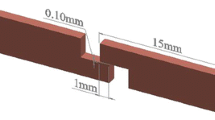Abstract
The constitutive modeling of creep has been extensively studied due to the important of the creep failure mode in solder joints. However, there are very few studies that considered room temperature aging contributions in their creep modeling studies. This study investigated constitutive modeling of creep of solders by taking into account the possible contribution room temperature aging. Lead-free solder (Sn–4.0Ag–0.5Cu) was found to have a higher creep resistance than Sn–Pb solder at the same stress level and testing temperature. The higher creep resistance was contributed by the second phase intermetallic compounds, Ag3Sn and Cu6Sn5. The precipitation of these intermetallic compounds can significantly block the movement of dislocations and increase the creep resistance of the material. Constitutive models of creep for both lead-free and Sn–Pb eutectic solders were constructed based on the experimental data. The activation energy for SAC405 is much higher than that of Sn–Pb, which also indicates that SAC405 possesses higher creep resistance. The constitutive models can be used in finite element analysis of actual electronic packages to predict solder joint failure. The creep mechanisms of both lead-free and Sn–Pb eutectic solders were also extensively discussed in this dissertation. Dislocation gliding and climb is believed to be the major failure mode at high stresses, while lattice diffusion and grain boundary diffusion is believed to be the major failure mode at low stress levels. Grain boundary sliding is believed to contribute to creep deformation at both high-stresses and low-stresses. For eutectic Sn–Pb, superplastic deformation is a major the creep mechanism at low-stresses and high-temperatures.
























Similar content being viewed by others
References
Garofalo F (1966) Fundamentals of creep and creep-rupture in metals. The Macmillan Company, USA
Hertzberg RW (1996) Deformation and fracture mechanics of engineering materials, 4th edn. John Wiley & Sons Inc, NY
Evans RW, Wilshire B (1985) Creep of metals and alloys. The Institute of Metals, London
Mukherjee AK, Bird JE, Dorn JE (1969) Trans Am Soc Met 62:155
Clech JP. Review and analysis of lead-free materials properties, NIST, Available at: https://doi.org/www.metallurgy.nist.gov/solder/clech/Sn-Ag-Cu_Main.htm
Ma H, Suhling JC, Lall P, Bozack M (2006) Reliability of the aging lead-free solder joints. In: Proceeding of the 56th electronic components and technology conference (ECTC), San Diego, California, May 30–June 2, 2006, pp 849–864
Ma H, Suhling JC, Lall P, Bozack M (2007) The influence of elevated temperature aging on reliability of lead-free solder joints. In: The proceeding of the 57th electronic components and technology conference (ECTC), May 2007, pp 653–668
Mitlin D, Raeder CH, Messler RW (1999) Metall Mater Trans A 30:115
Raeder CH, Mitlin D, Messler RW (1998) J Mater Sci 33(18):4503. doi:https://doi.org/10.1023/A:1004439931547
El-Rehim AFA (2008) J Mater Sci 43(4):1444. doi:https://doi.org/10.1007/s10853-007-2312-4
Cheng F, Nishikawa H, Takemoto T (2008) J Mater Sci 43(10):3643. doi:https://doi.org/10.1007/s10853-008-2580-7
Lau JH, Pang JHL, Ning-Cheng Lee, Luhua Xu (2007) Material properties and intermetallic compounds of Sn 3 wt% Ag 0.5 wt% Cu 0.019 wt% Ce (SACC). In: The proceedings of 57th electronic components and technology conference (ECTC07), pp 211–218
Tan KE, Xu L, Pang JHL (2008) Creep properties of Sn3 wt%AgO.5 wt%CuO.Ol9 wt%Ce (SACC) lead-free solder. In: The proceeding of 58th electronics packaging technology conference (ECTC08), pp 521–526
Dorn JE (1957) Creep and recovery. ASM Publication, Metal Park, OH, p 255
Weertman J (1968) ASM Trans Q 61:681
Hanke PL, Sprecher AF, Conrad H (1997) J Elec Materi 26:774
Schubert A, Walter H, Dudek R, Michel B, Lefranc G, Otto J, Mitic G (2001) Thermo-mechanical properties and creep deformation of lead-containing and lead-free solders. In: International symposium on advanced packaging materials, pp 129–134
Grivas D, Murty KL, Morris J, Jr (1979) Acta Metall 27:731
Dutta I, Park C, Choi S (2004) Mater Sci Eng A 379(40):1
Darveaux R, Banerji K (1992) IEEE Trans Compon Hybrids Manuf Technol 15(6):1013
Xiao Q, Armstrong WD (2005) J Elec Materi 34(2):196
Wiese S, Schubert A, Walter H, Dudek R, Feustel F, Meusel E, Michel B. Constitutive behavior of lead-free solders vs. lead-containing solders—experiments on bulk specimens and flip-chip joints. In: Proceeding of the 51st electronic components and technology conference, pp 890–902
Shi XQ, Wang ZP, Yang QJ, Pang HLJ (2003) J Eng Mater Technol 125:81
Zhang Q, Dasgupta A, Haswell P (2003) Viscoplastic constitutive properties and energy-partitioning model of lead-free Sn3.9Ag0.6Cu solder alloy. In: Proceeding of the 53rd electronic components and technology conference, pp 1862–1868
Darveaux R, Banerji K, Dody G (1995) Reliability of plastic ball grid array assembly. In: Lau JL (ed) Ball grid array technology. McGraw-Hill, New York, p 379
Vianco PT (2006) In: Shangguan D (ed) Fatigue and creep of lead-free solder alloys: fundamental properties. ASM International, pp 67–106
Lau J, Dauksher W, Vianco P (2003) Acceleration models constitutive equations reliability of lead-free solders and joints. In: Proceeding of the 53rd electronic components and technology conference, pp 229–236
Vianco PT, Rejent JA (2002) Compression deformation response of 95.5Sn-3.9Ag-0.6Cu Solder. UCLA Workshop on Pb-free Electronics. Available at: https://doi.org/www.seas.ucla.edu/eThinFilm/PbfreeWorkshop/pdf/vianco.pdf
Pang JHL, Xiong BS, Low TH (2004) Creep and fatigue characterization of lead-free 95.5Sn-3.8Ag-0.7Cu solder. In: Proceeding of 54th electronic components and technology conference, pp 1333–1337
Schubert A, Dudek R, Auerswald E, Gollbardt A, Michel B, Reichl H (2003) Fatigue life models for SnAgCu and SnPb solder joints evaluated by experiments and simulation. In: Proceeding of the 53rd electronic components and technology conference, pp 603–610
Author information
Authors and Affiliations
Corresponding author
Rights and permissions
About this article
Cite this article
Ma, H. Constitutive models of creep for lead-free solders. J Mater Sci 44, 3841–3851 (2009). https://doi.org/10.1007/s10853-009-3521-9
Received:
Accepted:
Published:
Issue Date:
DOI: https://doi.org/10.1007/s10853-009-3521-9




